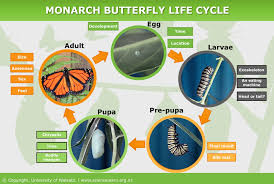There is so much to learn from Monarch Butterflies. I have been fascinated with Monarch Butterflies since I was a young girl. I didn’t really know much about them, or how long it would take for a caterpillar to become a butterfly, but I loved watching the process.

Get Latest Updates: Register for Emails—>>>
My Curiosity
Like most young children, I was very curious and wanted to learn new things. I found out that if I could find a caterpillar among the milkweeds, it would eventually turn into a butterfly.
The Miracle Begins

I searched and searched until I finally found one. I picked some milkweeds, put them in a jar, and made some small holes in the lid. Then I carefully put my new friend, the caterpillar, into the jar, tightened the lid and waited patiently. The caterpillar ate and ate until there wasn’t much left of the milkweeds. Soon it attached itself to the lid of the jar and began to form a sack around itself. It hung there on the lid for a time and then one day it began to emerge from the chrysalis. I carefully removed the lid and watched as it slowly unfolded it wings. I didn’t know how long it would take, but I was willing to wait and see for myself. Before I knew it a magnificent butterfly shook its wings and fluttered away. What an exciting and memorable experience for a young girl, who was full of curiosity.
The King of Butterflies

Did you know that the Monarch Butterfly is called the King of Butterflies? The name ‘monarch” is believed to be given in honor of King William III of England, whose secondary title “Prince of Orange” makes a reference to the butterfly’s main color. In addition, some people say they are the most beautiful of all butterflies, hence the name “Monarch.”
https://www.nationalgeographic.com/animals/invertebrates/m/monarch-butterfly/
Butterfly Life Cycle

Monarch Butterflies start out as eggs, which hatch into larvae. These larvae, eat their shells and subsequently, the milkweeds which they live on. Monarchs are dependent upon milkweed plants, for their survival. Soon the growing larvae become colorful caterpillars. They are able to create a protective case around themselves as they enter the pupa state. They live a grow inside this chrysalides, until it is time to emerge as a beautiful black and orange butterfly. A very interesting fact that I learned is: Butterflies that emerge from chrysalides (pupa state) in late summer and early fall are different from those that do so during the longer days and warmer weather of summer. The monarchs that emerge later are born to fly, and know because of the changing weather that they must prepare for their lengthy journey.
Monarch Migration
As we already learned, only monarchs born in late summer or early fall make the migration, and they make only one round trip. In north America, monarch butterflies migrate from the north in the fall and from the south in the spring. Monarchs cannot survive the cold winters in the north, and must find warmer climates of the southern United States or Mexico. Some fly as far as 3000 miles in this migration.
One of Nature’s Great Unsolved Mysteries is: How do they accomplish this annual migration? How do they know where to go, when it is so far away and they have never been there? Perhaps they have some sort of internal GPS system. This mystery will probably never be solved, but we do know that they are fascinating creatures.

I hope you enjoyed taking this journey with me into the life of the Monarch Butterfly. In the future I will be sharing more interesting facts and information so return often.


